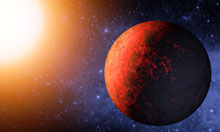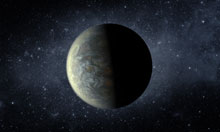Astronomers have spotted the two smallest, most Earth-like planets to be discovered outside our solar system. They are orbiting a star called Kepler-20 almost 1,000 light years away in the constellation Lyra. Reaching the two newly-discovered planets would take the fastest spacecraft more than 4m years.
The planets, Kepler-20 e and Kepler-20 f, are 1.03 and 0.87 times the diameter of Earth respectively. The previous record holder for the smallest planet found outside the solar system, Kepler-10 b, has a diameter 1.42 times that of Earth.
 Kepler-20 e. Image: Nature
Kepler-20 e. Image: Nature"The first of these planets has a diameter just 3% larger than the Earth, which makes it the closest object in terms of size in the known universe," said Dr François Fressin of the Harvard-Smithsonian Centre for Astrophysics in Cambridge, Massachusetts, who led the team of researchers that found the planets. "The second one is 13% smaller than the Earth. With a diameter around 7,000 miles, which is also smaller than Venus, it is in fact the smallest planetary body ever discovered in orbit of another sun-like star. Most importantly, it is the first time we cross the Earth-size threshold. In other words, it is the first time that humanity has been able to detect a planet of Earth's size or smaller around another sun."
The results, which come from observations by Nasa's Kepler space telescope, are published in Nature on Tuesday. The telescope, launched in March 2009, watches more than 150,000 stars for signs of orbiting planets.
The researchers believe that the inner planet, Kepler-20 e, orbits its sun every six days. It should be entirely rocky, made from an Earth-like blend of silicates and iron. The outer planet, Kepler-20 f, which orbits once every 20 days, is bigger and could have developed an atmosphere made of water vapour, according to Fressin. Surface temperatures of around 700C and 400C respectively would almost certainly rule out life on either planet. "We are unable to say what their exact composition is. The planets are likely too hot to harbour life as we know it. However, it is very likely that Kepler-20 f migrated inwards from an outer orbit, and could have been a habitable planet," said Fressin.
The planets were found by watching for objects periodically passing in front of the Kepler-20 star. As a planet transits, the starlight reaching Earth drops, so measuring the size of this effect can tell astronomers the size of the planet. "In the case of Kepler-20 e and 20 f, we were able to detect a periodic decrease in starlight smaller than 0.01% that occurred every six days for Kepler-20e and another periodic decrease that occurred every 20 days, for around two years. From these signals, we could determine the planet sizes and their orbital distance," said Fressin.
 Kepler-20 f. Image: Nature
Kepler-20 f. Image: NaturePreviously, scientists have reported the existence of three planets orbiting the Kepler 20 star, known as Kepler-20 b, Kepler-20 c and Kepler-20 d. These have diameters 1.91, 3.07 and 2.75 times that of Earth and orbital periods of 3.7 days, 10.9 days and 77.6 days respectively around their star. Earlier this monthastronomers announced the discovery of Kepler-22 b, one of the best candidates so far for an Earth-like planet outside our solar system. "This planet is interesting as it is fairly small and at the right location for water to be liquid," said Fressin. "However, the planet is very likely too large to harbour life as we know it."
Known planets around the size of Kepler-22 b, around 2.4 Earth diameters, most commonly resemble mini versions of the planet Neptune, the furthest planet from the sun in our solar system. These planets are mostly gaseous, with small rocky cores. "Although we do not know where the exact transition is between rocky planets and gas planets, Kepler-22 b is likely closer to Neptune," said Fressin.
Reposted from :www.guardian.co.uk/
Reposted from :www.guardian.co.uk/
